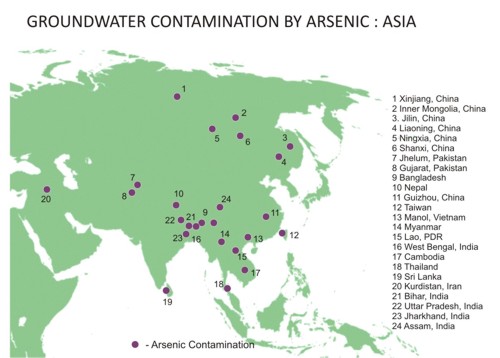


Designed by: Soumyadeep Mukhopadhyay
WHO has emphasised: "Arsenic in drinking water is a major public health hazard and should be dealt with as an emergency."
What is worrying is that the arsenic, which is swept down from the Himalayas and used to be deposited in silt on riverbanks, started becoming soluble between 30 and 40 years ago. Scientists say this is because the introduction of modern methods of intensive farming, using huge quantities of chemical fertilisers, upset the balance of nature.
In order to solve the problem, Dr Bhaskar Sen Gupta, (a senior lecturer in Environmental Engineering at Queen's University, Belfast who did his B.Tech in Chemical Engg from Jadavpur University, Kolkata, Masters from IISC, Bangalore & Ph.D from Malaysia) had to go back to basics and understand how the arsenic came to be in the water in the first place. Arsenic is present in the mineral matters deposited in the form of silt by major rivers in West Bengal and Bangladesh. The arsenic-bearing minerals exist in the shallow aquifer zones (up to 200ft soil depth) of the region. One popular theory of the presence of arsenic in the aqueous phase is biochemical activity of soil bacteria, which uses arsenic-bearing minerals as a source of oxygen. Intensive agriculture that uses high quantities of fertiliser further accelerates the bacterial action. The dissolved form of arsenic is far more toxic than the mineral form, which is abundant in the subterranean zone of the Bengal delta.
While researching the history of groundwater extraction, Dr Sen Gupta zeroed on a technique that had been used in Germany for well over a century to take out unwanted manganese and iron also removes the deadly arsenic. Sen Gupta flew to Stuttgart and at once realised that the precipitation process which removes the iron also precipitates the soluble arsenic. We did not have to invent something new. He pursued the ISWA, Stuttgart to let him apply that technology for arsenic removal. To find out its effectiveness in the Deltaic region, a TiPOT (Technology for in-situ treatment of groundwater for potable and irrigation purposes) project funded by EU was initiated at Kasimpore branch of Ramakrishna Vivekananda Mission, Barrackpore. After treating for a few months, the arsenic level came down from 300 �g/L to 10 �g/L. Dr Sen Gupta was proven right. But, a single case may not satisfy the critics. So he decided to take his idea to the next level.
Project Description and Objectives
The conventional technologies used in South Asia and elsewhere for arsenic removal are based on 'pump and treat' method involving either adsorption or membrane processes. Such plants are expensive to run and have problems associated with waste disposal and maintenance. In contrast, Subterranean Arsenic Removal (SAR) or �In-situ treatment� plants neither use any chemicals, nor produce any waste. Their installation is similar to a tube-well; all parts are easily available and can be installed by village technicians. Queen�s University Belfast is credited with setting up world�s first low cost and chemical free water treatment plant in the arsenic belt of India. Six such plants are now in operation in rural locations in West Bengal, close to Bangladesh border, with the financial assistance of the World Bank. These plants are being managed by local water users� association and are being used to supply water to the local population (www.insituarsenic.org). Each plant can produce up to 6000 litres of safe drinking water depending on the demand (arsenic concentration <10 ppb) with a typical production cost of 1 US$ for every 10000 litres. Subterranean groundwater treatment is based on the principle of oxidation and filtration processes of conventional surface treatment plants for removal of iron and manganese from water but has the added benefit of (i) enzymatic oxidation of As (III) to insoluble As (V), and (ii) huge adsorption space in the aquifer zone that removes arsenic along with iron and manganese, in a manner that does not clog the aquifer.
PROJECT BACKGROUND
TiPOT PROJECT
The TiPOT Project at Kasimpore was the pre-cursor of the World Bank Project DM 06-880. The consortium of some European Universities & Indian Research Institutes led by Dr Bhaskar Sen Gupta experimented with the In-situ Arsenic Removal Technology at Kasimpore under the funding of EU. After obtaining desired result, they decided to take their work to the next level by participating in the DM Competition of World Bank.
The TiPOT (Technology for in-situ treatment of groundwater for potable and irrigation purposes) project at Kasimpore on "Subterranean Arsenic Removal" was funded in the Asia Pro Eco Programme of the EU (Contract Reference No.: ASI/B7-301/2598/24-2004/79013).
Partners:
Dr Bhaskar Sen Gupta, Queens University Belfast (QUB)
National Metallurgical Laboratory, Jamshedpur, India (NML)
Institute for Sanitary Engineering, Water Quality and Solid Waste Management, Stuttgart, Germany (ISWA)
Universidad Miguel Hernandez, Alicante, Spain (UMH)
Institute of Environmental Management and Studies, India (IEMS)
Institute of Environmental Sciences, Leiden University, the Netherlands (CML)
Ramakrishna Vivekananda Mission- Institute of Advanced Studies (RKVM-IAS)
After the successful outcome in the TiPOT project, RKVM-IAS competed for the "Development Marketplace Global Competition, 2006" hosted by the World Bank in the "Water & Sanitation for the Poor People" Category & emerged as one of the Winners in this prestigious competition.
visit TiPOT website: www.qub.ac.uk/sites/TiPOT/
WORLD BANK PROJECT
Under the guidance of Dr Bhaskar Sen Gupta, an NGO Ramakrishna Vivekananda Mission - Institute of Advanced Studies (RKVM-IAS), Agarpara came out winner in the "Global Development Marketplace Competition" conducted by the World Bank in 2006 under the Water & Sanitation for the Poor People category. The World Bank allotted RKVM-IAS with fund for installing six in-situ arsenic treatment plants at six separate locations in rural Bengal.
Go to the project page at the World Bank Development Marketplace website
Site owned by: Bhaskar Sengupta, Heriot-Watt University, Edinburgh
